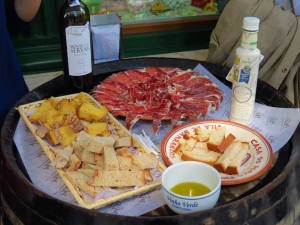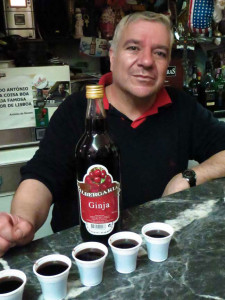There’s no better way to get to know some of the texture and history of Lisbon than by strolling about and sampling its highly varied, inviting, beguiling cuisine.
Taste of Lisbon, established by Filipa Valente in 2013, conducts leisurely-paced walking tours of the downtown area that simultaneously educate your mind and tantalize your palette. So, set aside three or four hours, lace up your walking shoes…and don’t eat in advance.
The afternoon walk, which meanders through the Downtown and Mouraria neighborhoods, starts in Largo de São Domingos in the heart of what’s called the new town. You’ll meet near a wall on which “Lisbon – City of Tolerance” is written in 32 languages – an apt nod to Portuguese cuisine that reflects and welcomes gastronomic influences from around the world.
Within a few minutes you’ll be standing in front of Manteigaria Silva (Rua Dom Antão de Almada, 1C). The name means “Place of Butter” and is a traditional grocery store that offers, among numerous items, salted cod from four countries, tinned fish (which is making a comeback after falling out of favor with the Portuguese in the 1980s), sausages (including those made from flour or chicken – invented by 16th Century Jews to fool the Inquisition into thinking they were Catholics who ate pork sausages), hard and soft cheeses, wines from throughout the country, wheat and corn bread, and other necessities to feed and soothe the Portuguese soul.
Be sure to sample the smooth, dry-cured ham called Porco Preto, made from black pigs from the Alentejo region that are raised on acorns, a highly revered delicacy throughout Portugal and eagerly sought in Spain and other European nations. Follow it with a glass of Monte das Servas Escolha, red wine also from Alentejo. Proprietor José Branco, Sr., who works primarily with small wine producers, offers a substantial selection of high quality, very affordable wines to satisfy a broad range of tastes.
Next stop: Zé dos Cornos (Beco dos Surradores, 5), the name of which derives from a story about the original owner who supposedly had cheated on his wife. Today, João and his wife seem happily married and keep busy feeding a local clientele at their Casa de Pasto, the general term for an eating house that is less formal than a simple restaurant. Here you’ll sit on stools, rubbing elbows with the regulars.
Zé dos Cornos is known for its pork ribs and rice with baked beans. If you’re not in the mood for a meal, ask for a bifana sandwich, grilled pork served in a bun. It’s called a prego if chicken is used instead. Ask the kitchen for its homemade Piri-Piri sauce, a spicy concoction made with chili peppers, lemon, garlic, salt, olive oil, and, sometimes, whiskey. Go easy at first, until you feel you can stand the temperature.
Be sure also to try the three-cheese platter. You’ll get St. George, from the Azorean island of the same name, a full-bodied cheese made from cow’s milk reminiscent of cheddar; a mild yellow cheese made of sheep’s milk; and a spicy cheese made from sheep and goat milk. The latter is served with quince marmalade, a combination known as a “Romeo and Juliet.”
Now, head to the Mouraria neighborhood, where the Moors were permitted to live following the Christian conquest in 1147 until they were expelled in 1492. The older part of this section is characterized by a maze of streets and alleyways, while the newer section, dating from the 18th Century, is more orderly.
First up is Moules & Gin (Martim Moniz), one of many food stands doing business at the Mercado de Fusão (Fusion Market), where many cultures meet through food, entertainment, and just plain enjoyment of outdoor life. As the name of this food establishment suggests, it’s the place to go for succulent, meaty mussels (and, yes, there’s more to drink than gin). You have a choice of sauces – French Meunière, made from cream, onions, and leeks; Thai, made from ginger, coconut milk, and lemongrass; and Bulhão Pato, a Portuguese specialty made from olive oil, white wine, garlic, lemon juice, and cilantro. We tried the Portuguese concoction, name for a 19th Century Portuguese poet and food lover who had written about a restaurant. The owner felt so honored that he returned the favor by naming the sauce for the author. It’s delectable.
Walking can create a thirst, which makes the next stop at Tasca os Amigos da Severa (Rua do Capelão, 32) a fortuitous one. It’s located in micro neighborhood where the Fado is thought to have originated in the 19th Century. Fado, meaning means fate or destiny, has a mournful tone, and has been inscribed on the UNESCO Intangible Cultural Heritage List. Many great Fado singers came from this neighborhood.
Today António da Severa, who has operated Tasca for 39 years, pays tribute to the Fado tradition, really apparent by the posters that cover every square inch of the walls of his tiny bar and the Fado music that envelopes you. Try to drop by before the locals fill the 5-x-15-foot space around 8 p.m. António will pour you a shot of Ginjinha, a popular Lisbon liqueur made from sour cherry berries called ginja. It goes down smoothly, perhaps too smoothly.
Head now to the “newer” part, Mouraria, situated by the hill that leads to the Moorish Castle of São Jorge, where if you make it to the top, you’ll be rewarded with fantastic views of the city and Tagus River.
But, first, it’s time to eat. Cantinho do Aziz (Rua de São Lourenço, 5) is an outdoor Mozambican restaurant wedged into a street corner. Why a Mozambican restaurant in Lisbon? It started when the great Portuguese explorer Vasco da Gama first landed on the shores of Mozambique in 1498. The Portuguese stayed on and on, until the country attained independence in 1975 after 10 years of fighting, shortly after democracy returned to Portugal in 1974.
Established in 1982, the kitchen is run by a man known simply as Aziz. An open, friendly man with a big smile that underscores his hospitable impulses, Aziz will ply you with the best samosa you’ll likely ever have eaten. When washed down with a cold Super Bock, a strong lager popular throughout Portugal, you’ll feel rewarded for persevering in your trek through Lisbon. If you’re hungry for a meal, that’s no problem; Aziz will take care of you.
No eating adventure would be complete without dessert, and for that, head nearby to Leopold (Rua de São Cristóvão, 27). Tiago Feio, who built a reputation as a fine cuisine chef, and his wife Anna have staked a claim in the more borderless world of creative cuisine. He cooks by temperature, not by time, and when his provocatively original dishes are precisely the right temperature, measured to tenths of a degree, they’re ready. We had Banana and Quezo de George (St. George cheese), a pleasing mix of textures and tastes: creamed banana topped with cinnamon-flavored crumbled biscuits and thin slices of the cheese – a savory-sweet delight.
A Taste of Lisboa, www.tasteoflisboa.com


